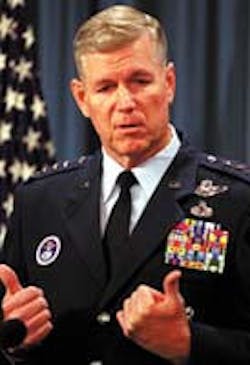President George W. Bush added a vocal supporter of advanced laser weapons to his inner circle in August when he named Air Force Gen. Richard B. Myers to be the chairman of the Joint Chiefs of Staff—under federal law, the principal military adviser to the president.
Myers has been vice chairman of the joint chiefs since March 2000 and as such has played a key role in overseeing Pentagon procurement programs. Before that, Myers was commander of the US Space Command, which is in charge of using and controlling space for military purposes.
While he headed Space Command, Myers was a strong supporter of development of an orbiting laser as part of a US ballistic-missile defense system—a position that will find a warm reception with both Bush and Defense Secretary Donald Rumsfeld. For example, Myers told the Senate Armed Services Committee in 1998 at a hearing on his nomination to head the US Space Command, that the space-based laser "might be one of those technologies that would aid us in the future if the threat would so dictate."
He specifically endorsed an Air Force project to demonstrate technology for a space-based laser. "That readiness demonstrator is an important technology development to make sure that we hedge against potential breakouts and threats against the United States. So, that is an important technology to be pursued." Myers told senators that he thought that the Anti-Ballistic Missile Treaty (ABM) need not stand in the way of research into a space-based laser—and he also appeared open to the possibility of scuttling the treaty altogether to deploy a space-based defensive systems. "I think we can work on those technologies in terms of research and in terms of demonstrations that wouldn't abrogate our current laws, treaties, or policies," he said. "And I think it's important to do that obviously before a decision is made to deploy a system like that we'd again have to look at our laws, treaties, and policies, and determine what our best national interest. But I think the research and technology piece of that is important."
A year later, Myers reiterated that viewpoint to the committee, saying that he sees an orbiting laser "as a critical component of a layered, integrated space and ground defense capability," because the laser could destroy attacking missiles in "boost phase," while the missiles' engines were still burning.
And a space experiment of a laser weapon planned for 2010 to 2012 is "vital," the general told the committee. He said that having the laser system become operational in the mid-to-late 2020s "is necessary to achieving our goal of an integrated space and ground-based ballistic missile defense capability."
However, Myers' interest in lasers extends beyond their use in ballistic missile defense. He is also concerned about the possibility that other nations could try to use ground-based lasers to damage vital US satellites—military or commercial—and he has suggested that the Pentagon should explore the option of developing laser weapons that it could likewise use against other nations. For example, Myers made headlines in January 2000 when he discussed the prospect of using ground-based lasers to attack US spacecraft.
"We know there are countries out there working on laser dazzlers that would perhaps have an impact on our electro-optical intelligence systems or other systems," Myers said. And he predicted that other nations could field laser systems in as little as five years. "It would not destroy the satellite," he said. "It just takes denial and deception to the next level."
Myers told reporters that the Pentagon should fire lasers at its own spacecraft to test the damage that could be done. The Defense Department is known to have conducted such an experiment only once, in October 1997, when the Mid-Infrared Advanced Chemical Laser, at White Sands Missile Range, NM, was fired twice at the Air Force's MSTI-3 satellite. ''We should understand our vulnerabilities,'' Myers said. ''This is a program that needs to be developed and fleshed out.''
Myers will be in a unique position to push for the laser programs of which he is such a fan. The Joint Chiefs of Staff carry great weight on Capitol Hill, and if their chairman endorses laser weaponry in a big way, lawmakers will undoubtedly sit up and take notice.
Clearly, Bush is counting on Myers' support for developing advanced technologies for the Pentagon. "General Myers is a man of steady resolve and determined leadership. His is a skilled and steady hand. He is someone who understands that the strengths of America's armed forces are our people and our technological superiority. And we must invest in both," Bush said in announcing his selection.
But the new chairman will face intense budget pressures from the military services, which often have been lukewarm toward missile defense and space weaponry, seeing them as siphoning off funds that are needed for more conventional weapons systems. Indeed, two days before announcing Myers' selection, the White House released a federal budget projection that indicated the government will have only $1 billion extra to spend on all discretionary programs—including, but not limited to, the military—in 2002, $2 billion extra in 2003, and $6 billion extra in 2004. Military chiefs are likely to fight hard for whatever extra funds they can eke out.
Rumsfeld seemed to acknowledge that Myers' support is not to be taken for granted. "You never know. You get married and you hope and pray," Rumsfeld said before Myers' name was formally announced, but after it had been leaked to the media. "So you kind of look at it all and then you roll the dice."
